It can be frustrating to be out for a hike in wet weather and have your jacket fail, which is called wetting out. But why do rain jackets wet out? And what can you do about it?
I’ve been hiking and backpacking for two decades, mostly in the wet Pacific Northwest weather of British Columbia. Over the years, I’ve tried a lot of rain jackets. And for seven years I worked at the head office of a large Canadian outdoor brand. My job was to write product guides and staff training materials, so I spent a lot of time working with the design and fabric teams to learn everything there is to know about outdoor fabric technologies.
In this article, I’ll give you everything you need to know about why rain jackets wet out. This guide includes:
- Why do rain jackets wet out? Four reasons your jacket might be leaking (or feel like it is leaking)
- How to prevent your rain jacket from wetting out: Five things you can do to stay dry
Hey there: Some of the links in this post are affiliate links, which means I earn a small commission at no cost to you. Thanks for your support. -Taryn
Why Do Rain Jackets Wet Out?
There are a few key reasons why your rain jacket is wetting out. The DWR coating wearing off is the most common one, but I’ll also explore other explanations such as clogged membranes, condensation build-up and failures of the membrane or seam sealing below.
DWR Coating Wears Off
The most common reason why your rain jacket might be wetting out is because the DWR coating has worn off. DWR stands for Durable Water Repellency. It is a thin coating of fluoropolymer that forms microscopic chains of molecules in little spikes. These little spikes ensure that water droplets bead up rather than spreading out on the surface of your jacket.
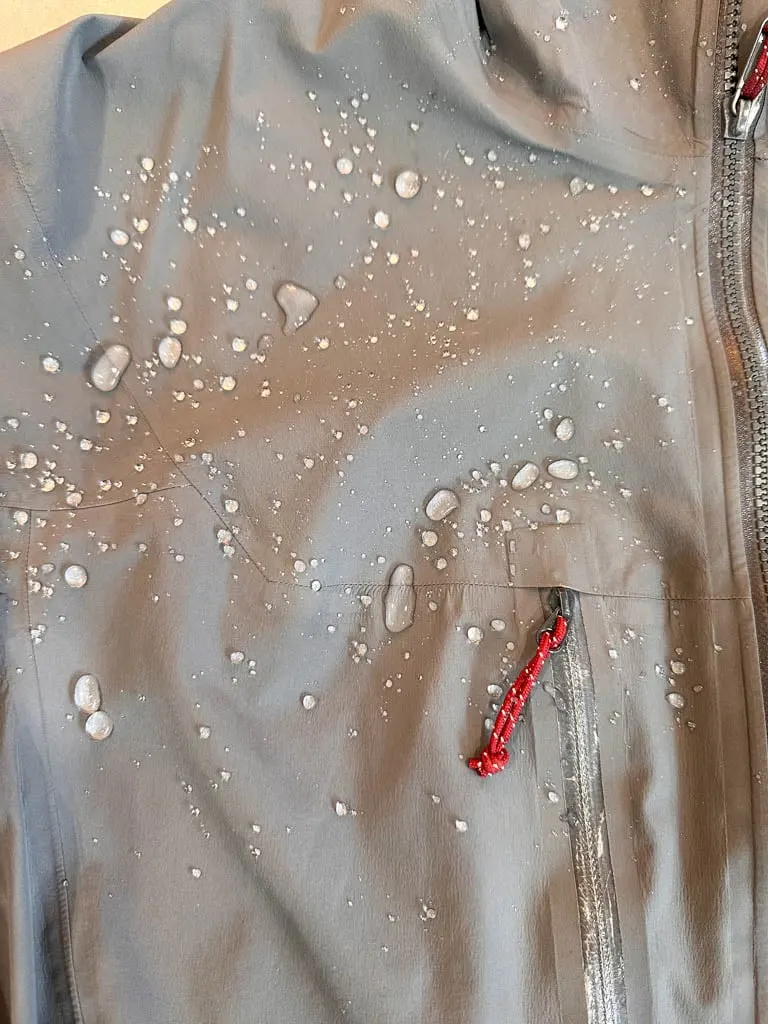
But this coating is fairly fragile and wears off over time. One of the main ways DWR coatings wear off is due to abrasion from rubbing against things. That’s why you’ll find the shoulders of your jacket wetting out first since they rub against your pack straps. You might also find your cuffs wetting out since your hands bump into things a lot. Dirt and body oils can can also contaminate the DWR.
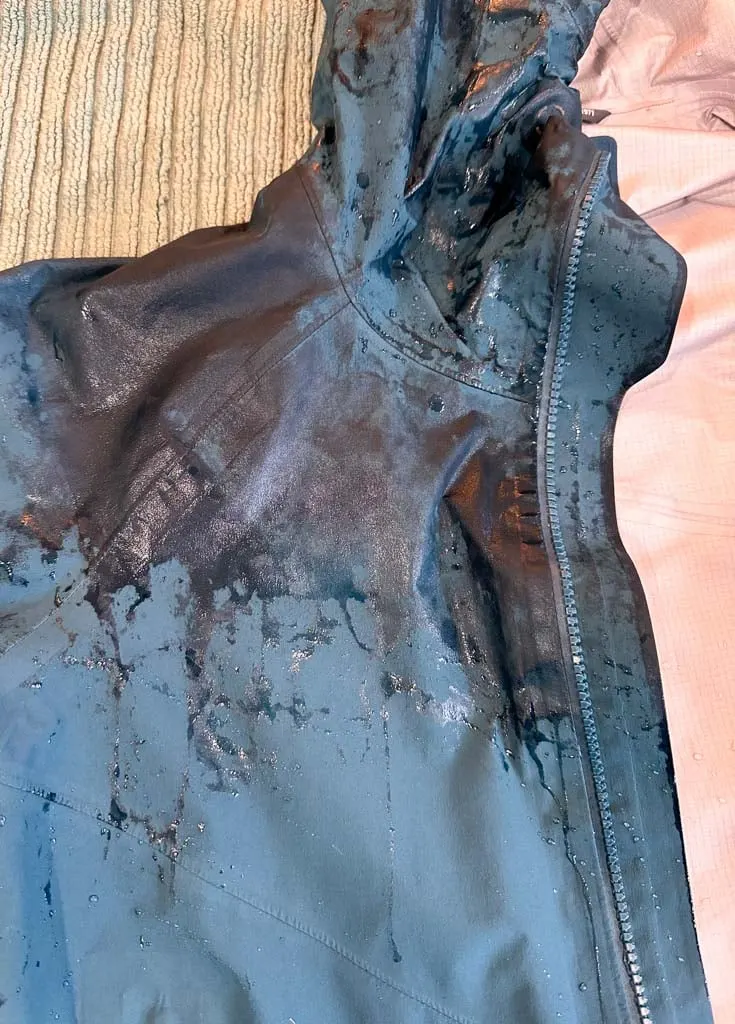
When the DWR coating wears out, the little fluoropolymer spikes bend over or break. That stops the water droplets from beading up, so the water spreads across the surface of your jacket. Without a DWR coating, the waterproof membrane in your jacket can still keep the water from coming in, but it can’t let water vapour from your sweat get out. That means that you will start to feel wet from the inside.
Unfortunately, since about 2016, the DWR on rain jackets has been wearing out faster. That’s because older DWR formulations worked better, but were less environmentally friendly. Newer DWR uses shorter chains of molecules, so the “spikes” aren’t as tall, so water doesn’t bead up as well. But that means that it isn’t as persistent in the environment, so it is safer.
Clogged Membrane
Your rain jacket has a waterproof breathable membrane that has tiny pores. The pores are small enough for water vapour from sweat to pass through (so you don’t overheat). But the pores aren’t big enough to let water droplets in.
Waterproof breathable membranes work great when they are new, but over time they can get clogged with dirt and body oils. Once the pores are clogged, water vapour can’t pass through and you’ll start to feel wet from the inside from sweat.
But there’s good news: You can wash your jacket to unclog the membrane and restore its waterproofing. (More about that in the prevention section below.)
Condensation
You might think that your jacket is leaking, but you are actually getting wet from sweat. This happens when your waterproof breathable membrane can’t let enough water vapour out and it starts to condense on the inside of your jacket.
You might get condensation because your DWR has worn off and water on the outside is blocking the pores of your membrane. Or you might have dirt and oil clogging your membrane.
Another reason for condensation build-up happens when you are generating too much body heat for your membrane. You might have a jacket with a low-quality membrane that just doesn’t breathe well. Or you might be working hard and sweating a lot. Humid weather makes the problem worse.
One of the key ways to fight condensation is to vent your jacket. Open up your arm-pit vents and chest vent. In warm weather, I don’t wear a rain jacket since it just wets out from the inside. Instead, I hike in a t-shirt and get wet. Then when I’m done hiking or get to camp, I change into a dry shirt and put my rain gear on.
Membrane and/or Seam Seal Failure
The last way that your rain jacket might be letting water in is if the membrane or seam seals have failed.
There are thousands of little needle holes along the seams in each waterproof jacket. Water can sneak in through these holes if they aren’t plugged. If you look at the inside of a rain jacket, you will see a layer of tape across each seam to keep water out.
Seam tape is stuck on with some kind of adhesive, and over time it can start to peel off or otherwise come unstuck. When this happens, your jacket will start to leak through the seams. Fortunately, you can reseal the seams with brush-on seam sealer.
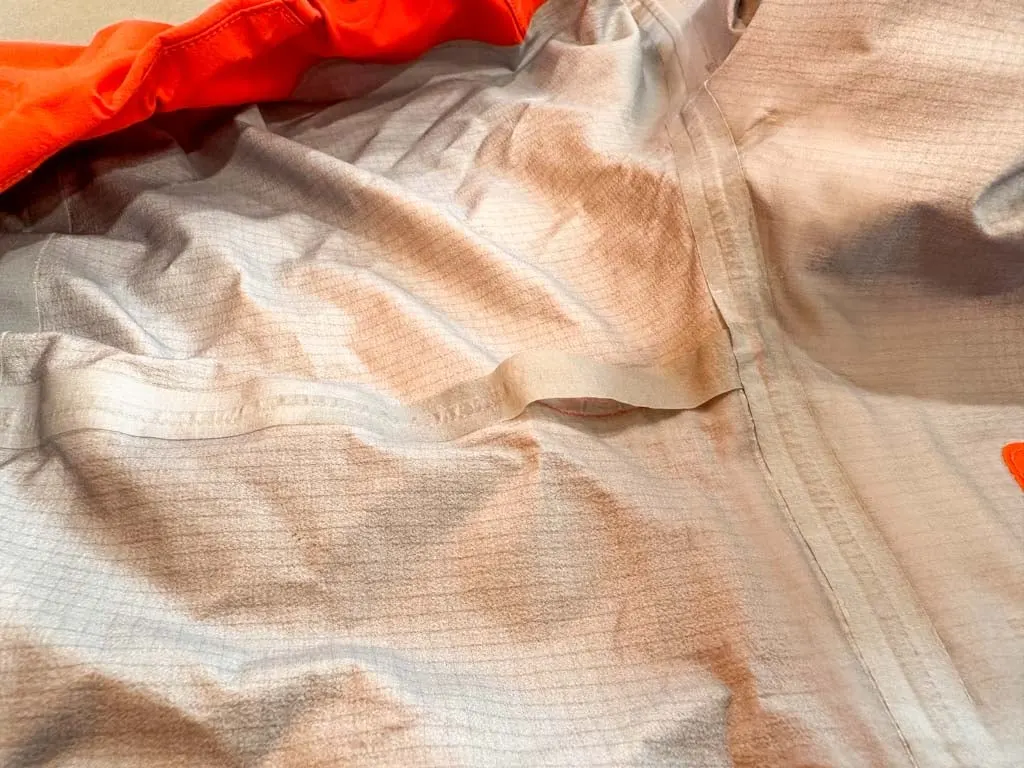
The waterproof membrane in your jacket can also fail over time. When that happens, the waterproof breathable membrane can start to flake off, crack, or develop bubbles. At that point, unfortunately, there isn’t anything you can do to fix it – your jacket has reached the end of its life.
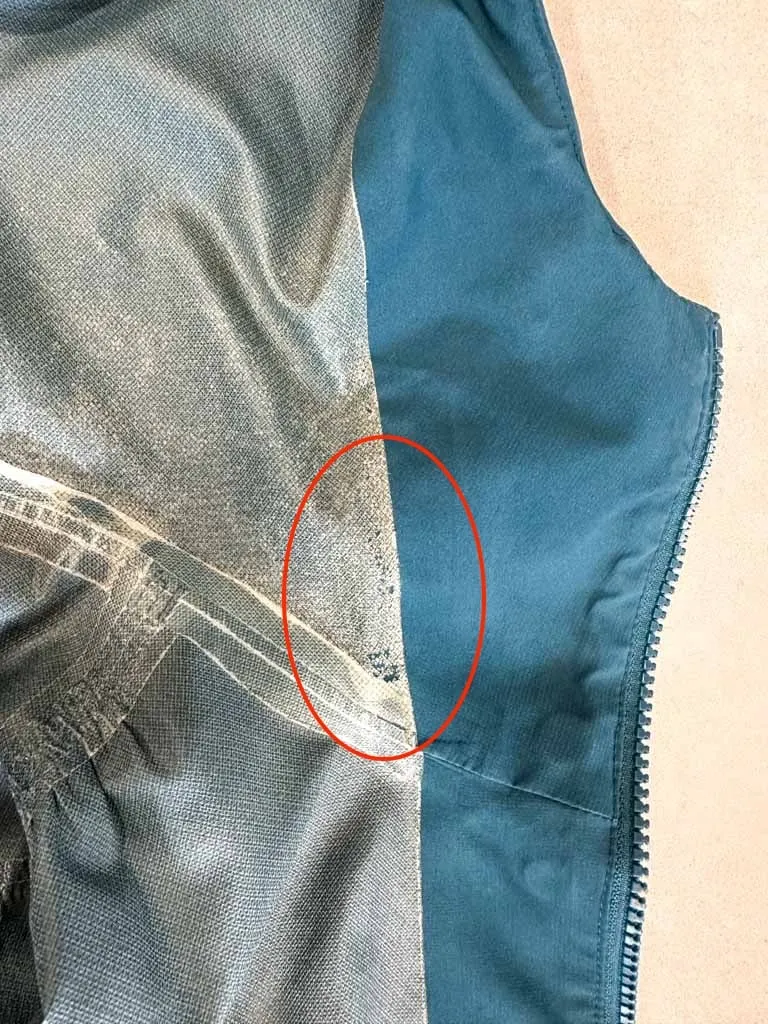
READ NEXT: 40+ Tips for Hiking in the Rain
How To Prevent Your Rain Jacket From Wetting Out
With a bit of planning and some on-the-trail techniques, it’s easy to prevent your rain jacket from wetting out. Here are a few things to keep in mind:
Wash it!
For some reason, lots of people are scared to wash their rain jackets. Don’t be! Washing your jacket regularly helps retain its waterproofing!
Since dirt and oils can clog your membrane or wear down your DWR, washing your rain jacket is an important way to keep it from wetting out. Be sure to follow the manufacturer’s directions when washing your jacket.
In general, close all zippers and Velcro, then wash it with a technical cleaner. I use Nikwax Tech Wash since it doesn’t leave behind residues like regular detergents can. Important note: washing your jacket with a technical cleaner will NOT wash off your DWR. Lots of people don’t wash their jackets because they are worried about wrecking their DWR. But as long as you use a technical wash, it’s better to wash your jacket than leave it all gunked up with dirt and oil.
Washing your jacket may be enough to restore its wet-weather performance. If you wear your jacket every day, you should wash it once a month. If you wear it less often, you can wash it less often.
With some jackets, putting them in the dryer on low or medium heat for about 20 minutes after washing can also help. But read the care label on your jacket first! Some shouldn’t go in the dryer.
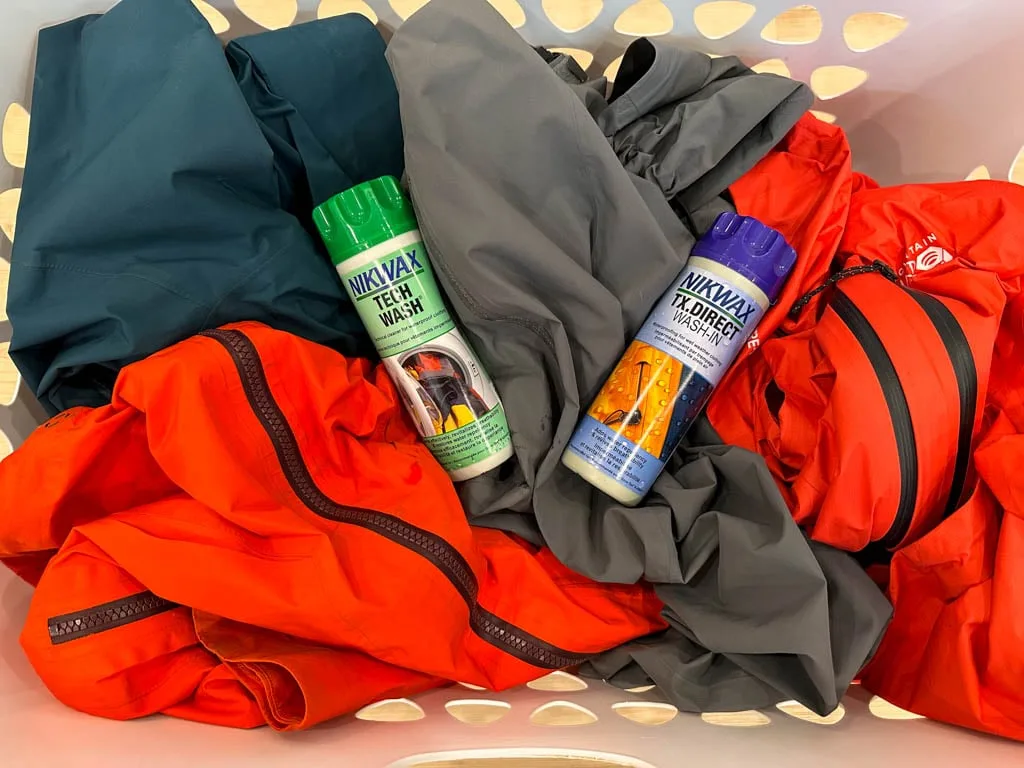
Refresh the DWR
Why do rain jackets wet out? Because the DWR has worn off! If you have washed your jacket and it is still wetting out, it’s time to refresh the DWR. It’s fairly easy to do either by spraying on a new coating or washing your jacket with a special DWR wash.
I like Nikwax TX Direct Wash-in because it’s easy to use – you just throw your rain in the washing machine with TX Direct and it penetrates the entire garment so you don’t have to worry about even coverage.
I’ve used TX Direct Spray-On before since it lets you get more coverage on high-wear areas like cuffs and shoulders. But it is messy so you have to use it outside or in a bathtub. I also find it harder to ensure I’m getting even coverage so I end up using more product than I would for the wash-in method. In general, I prefer the wash-in versions for ease of use.
Vent it!
Rain jackets aren’t magic – sometimes it’s just so humid out and you’re sweating so much that the membrane just can’t keep up. That’s where vents come in. If you regularly hike in the rain and/or run hot, it’s important to buy a rain jacket that you can vent.
The most effective type of rain jacket vents are pit zips since that’s where your body gets the hottest. As well, it’s hard for rain to sneak in via pit zips since your arms cover them.
But opening up mesh-backed chest pockets can also help you vent. Or you can ease down the front zipper a few inches. Unfortunately, you lose some waterproofing when you open vents, but it can be worth it.
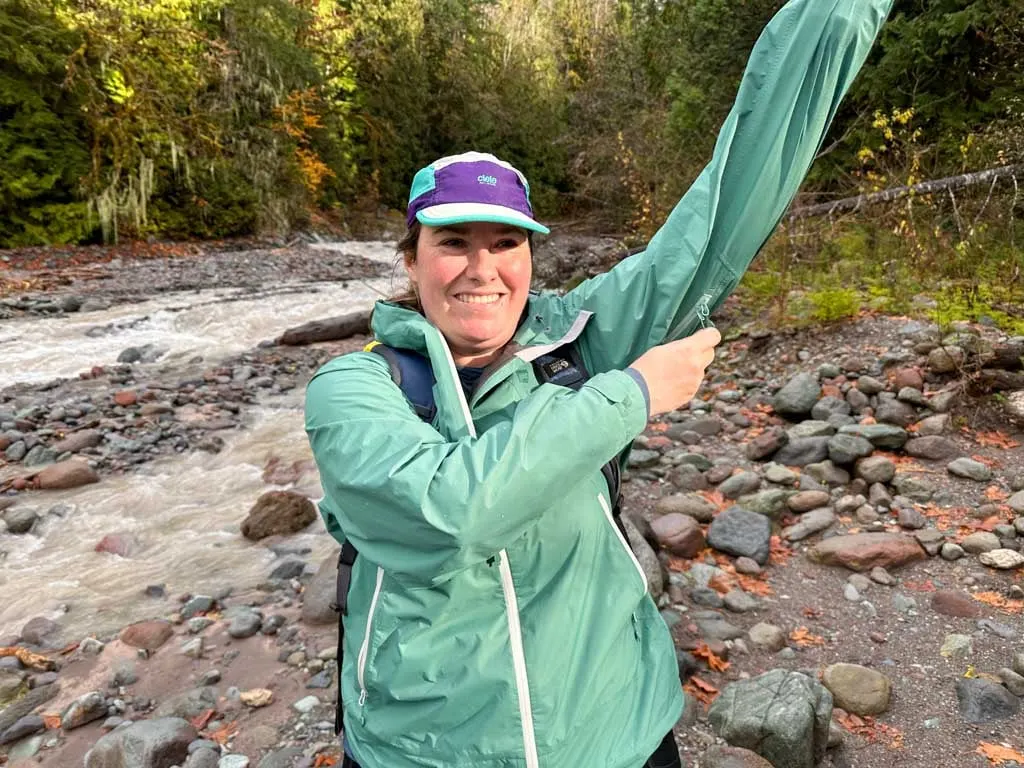
Reseal the Seams
If your seam tape is peeling off or bubbling up, you can fix it by applying a brush-on seam sealer like Seam Grip. However, this is a time-consuming process that can get messy if you aren’t careful. It also smells pretty bad. As well, the repaired seams will be a bit bumpy and not as pliable as the original tape.
However, if your seams are failing in many places, it may be a sign that your jacket has reached the end of its life. Check to see if the membrane is flaking off or bubbling too – seams and membranes often fail at the same time.
Buy a Quality Rain Jacket
You’ve probably heard the saying “Prevention is better than cure”. The easiest way to stop your rain jacket from wetting out is to buy a quality jacket to start with. Here are a few tips:
1. Buy from a Reputable Brand
There are tons of jackets on the market from different brands and with different types of waterproof technology. While the choices can be overwhelming, you can narrow it down a bit. Buy jackets from reputable outdoor brands who specialize in rainwear. Some safe bets are REI, MEC, Outdoor Research, Patagonia, Arc’Teryx, Helly Hansen, Mountain Hardwear, and Black Diamond. However, there are tons of other good brands.
Remember that most brands make a range of jackets and that cheaper jackets will generally have worse waterproof and breathable performance.
2. Pay Attention to Waterproof Breathable Technologies
While Gore-Tex used to be the gold standard, their patents expired in 1997 and many other brands use the exact same waterproof breathable technology.
Check to see if they list waterproof and breathable specs. Look for waterproofness of at least 10,000 mm. The higher the number, the more durable the waterproofing is. For fabric breathability, get a back that is rated at least 20,000g/m2/24h. Higher numbers are more breathable and will take longer to wet out.
Understand Rain Jacket Construction (2.5-Layer vs. 3 Layer vs. 2-Layer)
Rain jackets come in a few different types of construction, some of which are more prone to clogged membranes. Understand the pros and cons of the type of jacket you are buying and how prone to wetting out it will be.
Lightweight jackets often use what is called 2.5-layer technology. That means that the face fabric (1st layer) is laminated to the membrane (2nd layer). Then there is a thin scrim or veneer that is printed or sprayed on to protect the membrane (the .5 layer). This scrim is quite fragile and prone to breaking down from abrasion or body oils. But it makes the jackets rally light and easy to pack.
You can find both budget 2.5-layer jackets and high-end 2.5-layer jackets with more durable membranes. On the budget end, the Outdoor Research Helium Rain Jacket is popular and makes a great emergency shell, but the waterproofness and breathability are low. On the high-end, I love my Mountain Hardwear Minimizer. It is super-light and compact, but the Gore-Tex Paclite Plus fabric means it has great waterproofness and breathability. (It made my list of my favourite gear of 2023.)

Jackets with 3-layer construction laminate the face fabric to the membrane to a breathable inner liner fabric so the membrane is more protected. These tend to be premium jackets but they are a little bit heavier and bulkier than 2.5-layer jackets. In sustained rain, I opt to wear my 3-layer MEC Synergy or Helly Hansen Verglas Infinity since they are more durably waterproof and breathable.
In 2-layer construction, the face fabric and membrane are laminated together. A hanging liner (usually mesh) protects the inside and feels better against your skin. 2-layer jackets are heavy and bulky, but inexpensive. They usually use low-end membranes with lower waterproofing and breathability. Jackets with 2-layer construction are great for casual use or skiing, but I don’t recommend them for hiking.
So that’s everything you need to know about why rain jackets wet out and how to prevent it. Hopefully, this will help you stay drier on your next hike. Do you have rain jacket questions? Ask them in the comments.
READ NEXT:
- 40+ Tips for Hiking in the Rain
- The Best Weather Apps for Hiking
- How to Get the Smell Out of Hiking Clothes
- Is Merino Wool Worth It? Pros and Cons
- How to Stay Warm in a Tent: Over 40 Tips
- Lake O’Hara Packing Lists for Hikers and Campers - April 25, 2025
- BC Parks Day Passes 2025 – Everything You Need to Know - April 24, 2025
- Best Women’s Hiking Pants (Picks for Every Body Type) - April 21, 2025


lburns
Monday 19th of August 2024
I recently had a raincoat "wet out" after 18 years. I returned it to Patagonia and received credit equal to what I had paid for it nearly two decades earlier. This covered about 70% of the price of the replacement coat. Life time guarantee comes with everything they make.
JB
Wednesday 21st of February 2024
Thank you for the great tips and clear explanations!